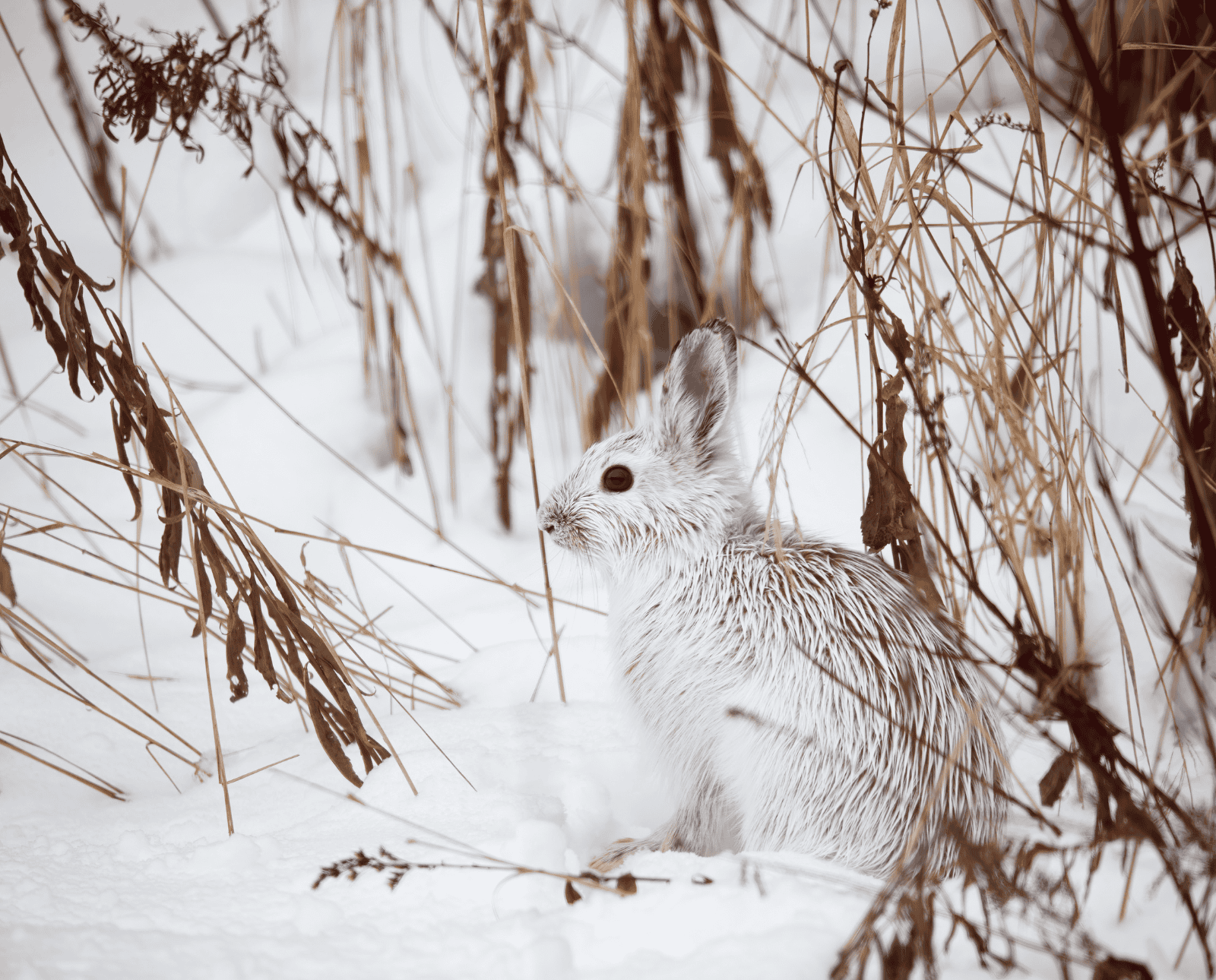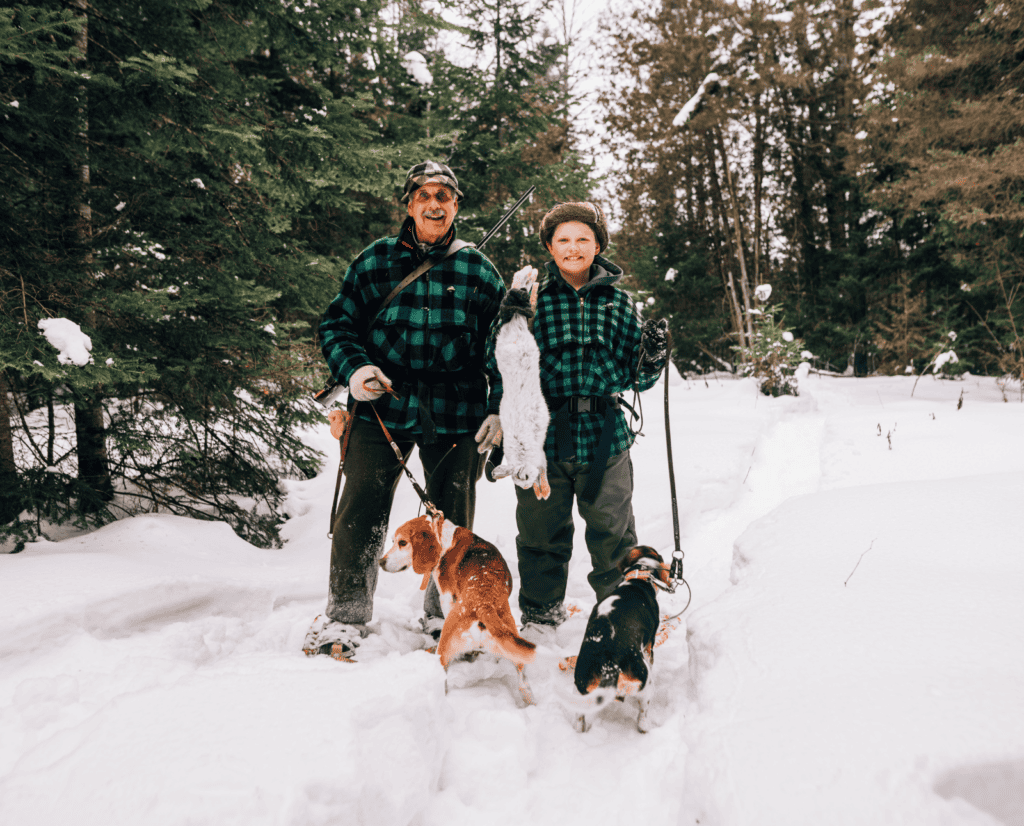Home » Small Game Hunting » Rabbit Hunting » A Complete Guide to Late Season Snowshoe Hare Hunting
A Complete Guide to Late Season Snowshoe Hare Hunting

Born and raised in southern Ontario, it wasn't until Mike…
Make the most of winter’s final days by embracing the cold and methodically working through snowshoe hare habitat.
Let’s say it’s March, and your geographical location is covered in snow. There’s no sign of spring to be seen. Sure, there’s more hours of daylight, but spring gobbler and black bear seasons are still a long way off. So, what kind of hunting opportunities are available? Actually, some of the best small game hunting of the entire year can be had right this very minute. Well, if you live in snowshoe hare country, that is.
In my neck of the woods, winter is usually on its way out in a pretty big way between the end of February and the first couple of weeks of March. In many of the management units that I hunt, the open season for snowshoe hares (sometimes called varying hares in the regulation books) remains open until the end of the latter month. This, no matter how you slice it, is a blessing.
Late season snowshoe hare hunting is a bit different than early season snowshoe hunting. Here are a few pointers for adding a hare or two to your game bag during the tail end of winter.
Snowshoe Hares Begin To Pair Up In February
While there may be deep snow in late February, it makes no difference to the hares. In fact, the upcoming breeding season can make targeting hares easier for the prospective small game hunter. During the breeding season, which can last up to September, hares pair up. In other words, two snowshoe hares can be found, albeit quite loosely, near each other. Comparatively, this is not a common occurrence during the early season.
What paired snowshoes mean for the late winter hunter is that when you happen to flush one of these wintry white lagomorphs from cover, there is often another one within close proximity. I have found this to be the case more often than not. Depending on how good the cover is, walking a wide circle to roughly thirty or forty yards from where the first hare was flushed often yields a second hare flushed, too.
The average size of a snowshoe hare’s home range is often no bigger than twenty acres. They often overlap with the home range of other snowshoe hares. However, during this time of the year, you are far more likely to find pairs within close proximity to one another. If you are running beagles, be prepared for doubles.

Slowly Work Your Way Through Snowshoe Cover
Small game animals (hares included) are usually very familiar with their local landscape. As a result, they know exactly where to seek refuge from winter conditions. If the winter has been particularly harsh, hares will put more energy into burrowing into the snow especially at the base of coniferous trees with low lying branches.
What does this mean for the dedicated hare hunter? You need to take your time working through any given area that you know for a fact harbors hares.
If you had to choose one kind of weather condition to hunt snowshoes during the late season, choose a very cold, very sunny afternoon. Hares may be a hinterland species, but even they get chilly. When the sun is out but the mercury plummets, I regularly find snowshoe hares puffed up at the base of their burrows, catching as much sunlight as possible during the heat of the day.
In those cold, sunny conditions, someone like me is far more likely to go for a long walk with a very accurate, scoped .22LR rather than a shotgun. Nine times out of ten, your shots will be aimed at a stationary target that doesn’t want to expend any more energy than is absolutely necessary.
I cannot stress enough the importance of walking slowly. This is the only time of year that I consistently bring a pair of binoculars with me afield. More than once have I been standing still, breaking apart a small area with my optics, only to find a hare that has maintained its composure. Sometimes, these stock-still critters hold as close as 15 yards.
Remember, It’s Still Winter—Dress Appropriately
Even though winter is on its way out, conditions can still be harsh. If your area has accumulated a lot of snow, acquire a pair of snowshoes appropriate for dispersing your body weight. You’ll get around a little easier in those places hares call home.
Snowshoes or not, you’re more than likely going to work up a sweat. Wearing a good, moisture-wicking base layer is important. There are plenty of synthetic options for winter hunters out there. (For a long time, I used layers designed for playing hockey.) But, best I can tell, no material works better than merino wool.
Note that this sort of hunting can be physically taxing, too. If nothing else, stretch prior to leaving the vehicle, especially if the snowpack is deep. A little stretching can, and often does, go a long way toward preventing pulled or strained muscles in the backcountry.
Late Season Snowshoe Hare Hunting Strategies For When Winter Leaves Early
Sometimes, we get lucky and a big thaw, which seems to be happening more and more in recent years, comes along and melts most of the snow away. Secluded pockets of densely shaded cedars or pines are the only places snow remains. Now, you’re really in business.
Popular science says that snowshoe hares can’t control when their fur changes from brown to white and then back again. It’s completely dependent on the hours of daylight. This means that if there’s a major thawing event in March, you might find that you’re hunting white hares in a sea of brown. Sounds too good to be true, right?
Well, hares have contingency plans for when this happens. One of those plans is to concentrate in dense cover where pockets of snow and ice remain during the day. One time, after several days of warmer-than-average temperatures mixed with rain, a hunting partner and I found a secluded cedar stand with low lying juniper bushes around its fringes. The entire cover was less than fifty yards long and twenty yards wide, but it had snow still in it. Because of the snow, it was home to no fewer than five individual snowshoe hares.
It’s remarkable to find densely concentrated hares. But what made that day even more remarkable was that no matter how many times we flushed those hares from their cover, they refused to leave that pocket of protection. We took three home with us that day.

Hunting With A Partner Can Make Your Snowshoe Hare Hunt More Efficient
I love hunting alone. However, when it comes to late season snowshoe hare hunting, having at least one other like-minded person along helps take a lot of the guesswork out of an area. Having a partner who can scope out one spot while you tackle another helps pinpoint where the hares are.
Another reason I prefer hunting with a partner during the late season is because, as a team, you can cover more ground. This usually equates to a faster, more accurate understanding of where snowshoe hares are this time of year.
As a general rule, I don’t set up drives to move snowshoe hares like I would during the early season or even mid-season. Instead, having specific, predetermined areas in mind for each individual hunter to slowly and methodically work through yields better results. However, if there is no snow on the ground, maybe consider doing a couple of pushes. But most years, driving snowshoe hares in February is simply not possible.
Again, remember that just because it’s the late season, it doesn’t mean that traversing your way through the landscape will be easy. Watch the conditions ahead of time and be aware of what you are in for.
Safety Is Of The Utmost Importance
My number-one late season snowshoe hare hunting strategy involves two or more hunters splitting up in hazardous country. Usually, everyone carries a scoped .22 rifle as well. I cannot stress enough the usefulness of having a first aid kit (or better yet, two), two-way radios, and blaze orange.
Do not underestimate the usefulness of wearing more hunter orange than you think is necessary. It might seem ridiculous, but trust me when I say that wearing excessive amounts of blaze orange has saved my skin more than a few times.
Late season snowshoe hare hunting presents a unique and rewarding opportunity for small game hunters willing to embrace the challenges of deep snow, cold temperatures, and changing hare behavior. By understanding their late-winter habits—such as pairing up, seeking cover, and adapting to fluctuating conditions—you can maximize your chances of success. Whether hunting solo or with a partner, moving methodically through prime habitat and staying mindful of safety considerations will make for a highly enjoyable outing.
If the snow is still on the ground and you’re looking for one last hunting adventure before spring, grab your gear and head out to snowshoe country. When it comes to experiencing the thrill of late season snowshoe hare hunting, there’s no better time than the present.
Born and raised in southern Ontario, it wasn't until Mike was in his late twenties that he started hunting and immediately took a strong liking to the pursuit of small game. Snowshoe hare, cottontails, eastern grey squirrels, grouse, and woodcock all have a place in his heart. When not in the woods, Mike is on the water with a fly rod chasing fish with flies that I tied from the animals he's hunted. What a life!



